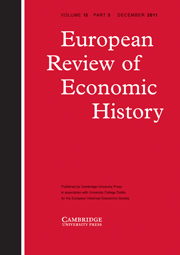Crossref Citations
This article has been cited by the following publications. This list is generated based on data provided by
Crossref.
Hale, Matthew
Raymond, Graham
and
Wright, Catherine
2010.
List of publications on the economic and social history of Great Britain and Ireland published in 2009.
The Economic History Review,
Vol. 63,
Issue. 4,
p.
1129.
Bordo, Michael D.
Humpage, Owen
and
Schwartz, Anna J.
2011.
U.S. Intervention During the Bretton Wood Era: 1962-1973.
SSRN Electronic Journal,
FAITH, ROSAMOND
SCHOFIELD, P. R.
HEALEY, JONATHAN
MURPHY, ANNE L.
BRADLEY, KATE
TAYLOR, JAMES
and
BROWNLOW, GRAHAM
2011.
Review of periodical literature published in 2009.
The Economic History Review,
Vol. 64,
Issue. 1,
p.
256.
OLIVER, MICHAEL J.
2012.
The two sterling crises of 1964: a comment on Newton.
The Economic History Review,
Vol. 65,
Issue. 1,
p.
314.
Roberts, Richard
2013.
‘Unwept, unhonoured and unsung’: Britain's import surcharge, 1964–1966, and currency crisis management.
Financial History Review,
Vol. 20,
Issue. 2,
p.
209.
RockoffWhite, HughEugene N.
2015.
Current Federal Reserve Policy Under the Lens of Economic History.
p.
318.
Bordo, Michael
Monnet, Eric
and
Naef, Alain
2019.
The Gold Pool (1961–1968) and the Fall of the Bretton Woods System: Lessons for Central Bank Cooperation.
The Journal of Economic History,
Vol. 79,
Issue. 4,
p.
1027.
Pasula, Kit
2020.
Reserve flows and monetary autonomy under a fixed exchange rate: the British experience under Bretton Woods.
Applied Economics,
Vol. 52,
Issue. 17,
p.
1891.
Kuehn, Daniel Peter
2020.
‘No Business of the Rest of the World’: Milton Friedman and IMF Conditionality.
SSRN Electronic Journal ,
Accominotti, Olivier
Briere, Marie
Burietz, Aurore
Oosterlinck, Kim
and
Szafarz, Ariane
2020.
Did Globalization Kill Contagion?.
SSRN Electronic Journal ,
David, Géraldine
Li, Yuexin
Oosterlinck, Kim
and
Renneboog, Luc
2021.
Art in Times of Crisis.
SSRN Electronic Journal ,
Naef, Alain
2021.
Dirty float or clean intervention? The Bank of England in the foreign exchange market.
European Review of Economic History,
Vol. 25,
Issue. 1,
p.
180.
Bordo, Michael D.
and
Levy, Mickey D.
2021.
Do enlarged fiscal deficits cause inflation? The historical record.
Economic Affairs,
Vol. 41,
Issue. 1,
p.
59.
Banerjee, Joshua J.
2024.
UK fiscal policy and external balance under Bretton Woods: Twin deficits or distant relatives?.
The Economic History Review,
David, Géraldine
Li, Yuexin
Oosterlinck, Kim
and
Renneboog, Luc
2024.
Art in times of crisis.
The Economic History Review,
Vol. 77,
Issue. 4,
p.
1362.


